Share of Voice Amazon and how it helps you take over the marketplace
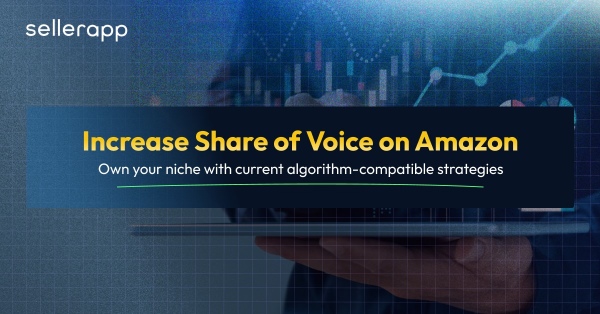
On Amazon, visibility isn’t always accidental; it can be engineered and represented as Share of Voice Amazon.
In a marketplace where thousands of sellers compete for the same customer base, how often your brand shows up within the SERPs determines whether you scale or stay stagnant.
Share of Voice tells you if your ads are winning, if your keywords are defended, and if your presence is commanding or invisible.
In this guide, we’re going beyond basic definitions. We’re explaining how advanced sellers measure, interpret, and grow their Amazon Share of Voice, not just for clicks, but to effectively capture more market share.
From using keyword clusters and branded term strategy to retargeting loops and precision budget shifts, we’ll also break down how top Amazon PPC agencies like SellerApp engineer SOV growth through data, automation, and experience.
What is Share of Voice (SOV) Amazon?
Share of Voice (SOV) on Amazon refers to the percentage of visibility your brand or product has in comparison to your competitors within a specific category, keyword, or ad space of the Amazon marketplace.
It’s a key metric that helps measure how dominant your presence is on Amazon search results pages, ads, and Amazon product listings.
Amazon Share of Voice of in a way, is the attention your brand captures in a crowded marketplace.
What is an example of Share of Voice in marketing?
If you’re selling wireless chargers and your listings or ads appear for 30 out of every 100 relevant keyword searches, your SOV is 30%.
That means you’re getting 30% of the customer attention, while the rest 70% goes to your competitors.
So now that you know what Amazon Share of Voice means, it’s worth mentioning another closely related concept. The Share of Shelf.
While Share of Voice (SOV) is all about how often your brand shows up when customers are searching or browsing the Amazon marketplace platform, Share of Shelf focuses on where and how your products appear on the actual product pages.
Think of it this way.
Share of Voice on Amazon tells you how often you’re being seen.
Share of Shelf tells you how much space you take up when you are seen.
For example, if a customer searches for “floral tops” and the first page shows five of your store listings out of 20, that’s a 25% Share of Shelf. If your ads or listings appear in 30% of all search impressions for that term, that’s your Share of Voice.
Both metrics matter, but in different ways.
SOV helps you understand your reach, while Share of Shelf reflects your real estate on high-traffic pages, which can heavily influence conversions.
What is an indicator of a good Share of Voice Amazon?
Share of Voice Amazon is a strategic indicator of competitive dominance and brand mindshare within the Amazon SERPs. But what qualifies as a “good” SOV on Amazon? The answer lies in context.
There’s no universal percentage as an indicator but it’s about owning key real estate across your most valuable keywords, consistently and profitably.
Here’s how to typically benchmark Share of Voice Amazon:
- 20–30% Share of Voice (SOV) is considered a strong foothold. It means you’re present across multiple entry points, likely balancing organic rankings with paid placements.
- 40–50% Share of Voice (SOV) puts you in a category leadership territory. You’re top-of-mind for both shoppers and the algorithm. At this point, you have a stronger brand recall and higher conversion velocity.
- 60% + Share of Voice (SOV) means you’re dictating the market tempo and influencing keyword economics, CPC trends, and buyer behavior.
However, a high Share of Voice on Amazon doesn’t always equate to high ROI.
Top brands prioritize SOV quality over SOV quantity. That means focus should always be on:
- High-intent, bottom-funnel keywords.
- Defensible ASIN placements (especially in sponsored brand and sponsored product slots for directly influencing customers’ click behavior and purchase intent).
- Competitive intelligence to avoid overbidding for non-strategic visibility.
In short, a “good” Amazon Share of Voice is one that aligns with your margin thresholds, complements your organic ranking strategy, and outpaces competitors on keywords that actually move the needle.
What is the Share of Voice Amazon rule?
Here’s something every seasoned Amazon seller should keep in mind about Share of Voice Amazon. It is the fact that visibility creates momentum.
How to gauge it?
If your brand is getting more visibility (which is Share of Voice Amazon) than it’s currently converting into sales (which is market share), it usually indicates that growth is on the horizon. You’re showing up more than you’re selling, so it’s only a matter of time before the sales catch up.
That’s the core idea behind the Amazon Share of Voice rule. When applied right, it can be a game-changer for your brand.
Let’s say you’re competing in the board game category.
You’ve got Amazon’s Share of Voice on 40% of the most valuable search terms, but you’re only capturing 25% of the sales volume.
According to the Share of Voice Amazon rule, you’re primed for growth because your brand is commanding attention beyond what your current sales numbers would predict.
But there’s another side to it.
If your Share of Voice on Amazon drops below your share of the market, that’s a red flag. It means competitors are catching up, and your visibility might not be strong enough to hold your position. What matters more than getting clicks is owning the awareness of your ideal customers.
Why Is Amazon Share of Voice Important?
Here’s why Share of Voice Amazon should be a core KPI across your brand, marketing, and operations teams:
1. Predictive Indicator of Market Leadership
As mentioned earlier, a high Amazon Share of Voice often precedes an increase in Share of Market. Leading brands monitor this correlation because it’s noticed whenever the Share of voice Amazon exceeds your current market share, growth typically follows.
Identifying these shifts early, within the share of voice Amazon reports, you can forecast future moves, evaluate the impact of new launches beforehand.
2. Strategic Budget Allocation & Ad Efficiency
Share of voice Amazon helps ensure you’re not just spending, but spending with intent, with precision, and purpose. Brands that track Share of Voice on Amazon at a granular level. The tracking is done across specific keyword clusters and ASIN targets to allocate ad budgets strategically with precision.
Thus, you backtrack from blindly pouring ad spend into broad, high-volume terms (that look good on paper but don’t convert). Instead, you can double down on the exact search terms and product placements that actually drive profitable results.
This kind of surgical targeting helps you:
- Maximize ROAS by bidding where conversion rates are proven.
- Lower TACoS by aligning spend with organic momentum.
- Eliminate wasted budget on low-impact impressions.
3. Category Domination & Keyword Defense
Your share of voice Amazon isn’t just about how often you show up; it’s also about where you show up (Share of Shelf). By keeping an eye on your share of voice at the keyword level, top brands don’t just wait around.
They actively catch shoppers who might be looking at the competition, and make sure their products show up in those high-converting, premium spots. You can use the keywords for running Sponsored Products, Sponsored Brands, or DSP, which will ultimately help you lead your category.
If you’re not showing up consistently in high-traffic keyword searches (low Share of Voice Amazon), you won’t get many chances to occupy Share of Shelf. On the flip side, even if you have a few ASINs on page 1, but your Share of voice (Amazon) is low across keywords and placements, your Share of shelf is probably fragile and short-lived.
So, securing a strong Share of Voice Amazon is important before you assess the Share of Shelf for your product.
4. Assessing Brand Health
Consistent drops in Share of Voice on Amazon can be an early warning sign for Amazon sellers. Flagging issues like inventory stockouts, ad fatigue, increased competition, or creative underperformance.
On the flip side, rising SOV indicates growing brand equity, algorithmic favorability, or strong customer response. Tracking your Share of voice (Amazon) helps you keep a tab on brand momentum, even before sales metrics make it evident.
5. Influences Organic Rank and Long-Term Visibility
Amazon’s algorithm rewards products that perform well in both paid and organic placements. By increasing your Amazon Share of Voice, particularly focusing on high-intent search terms, you’re training the algorithm to trust your ASINs.
This results in direct improvement of organic rank, more frequent on-page placements (like “Frequently Bought Together” or “Sponsored Related Items”), and you can expect it to compound over time.
6. Cross-Functional Decision-Making Metric
Share of Voice provides insights that can influence your inventory planning, product development, pricing strategy, and more. One tool that can change the course of your strategy-making, but for good.
Say, if your share of voice Amazon is strong but conversions are lagging behind, it is a clear indication that there might be a pricing mismatch. In case your Share of Voice (SOV) suddenly drops, supply chain or availability issues might be the root cause. Thus, it becomes a cross-functional indicator for detecting performance bottlenecks.
7. Signals to Retail Algorithms and Brand Perception
Retail algorithms (especially on Amazon) respond to brand momentum. A high, sustained share of voice on Amazon signals the algorithm that your brand is relevant and trusted.
This can influence winning Buy Box. Moreover, when your products maintain consistently high visibility, it impacts how customers perceive your brand, increasing your overall brand value.
This fosters brand recall and even determines how flexible they are with your pricing.
How to Calculate Share of Voice on Amazon
Calculating your Amazon Share of Voice (SOV) isn’t complicated once you know the correct method.
Like we mentioned before, Share of Voice on Amazon tells you how often your brand appears in key placements compared to competitors across search results, ads, and product listings.
Here’s the formula to effectively calculate Share of Voice (Amazon):
Share of Voice (SOV) = (Your Brand Impressions / Total Category or Keyword Impressions) × 100
You can calculate this at different levels, using keywords, ASIN, category, or ad placement type (Sponsored Products, Sponsored Brands, etc.).
Here’s a practical example of how to use it.
Let’s say you’re selling protein powder under the health and wellness category. For the keyword “unflavored whey”, your Sponsored Product ads generated 25,000 impressions over a 30-day period. (Your Amazon Campaign manager data will give you the details.)
If all Amazon sellers combined generated 100,000 impressions for that same keyword, your Share of Voice on Amazon will be (25,000 / 100,000) × 100 = 25%
That means you had a 25% share of voice on Amazon for the “unflavored whey” keyword. Thus, your brand showed up in 1 out of every 4 searches in the SERPS.
But to calculate this, you need datasets.
Search for impressions in Amazon Sponsored Ads Reports (under Impression Share).
Third-party intelligence tools like SellerApp can give SOV breakdowns by keyword, ASIN, or ad type if you opt for custom reports. If you’re looking for a quick, streamlined, and more holistic view across categories, third-party analytics tools such as SellerApp can help you with Amazon Share of Voice.
Optimize Product Listings to Increase Share of Voice on Amazon
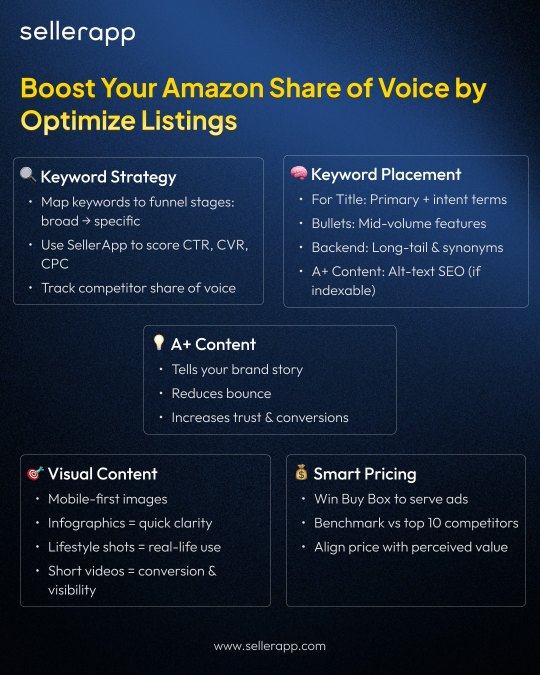
Your product listings are the easiest aspects you can control when it comes to expanding your Amazon Share of Voice.
Before you scale ads or double down on ads, your listings need to convert exceptionally well. Amazon’s ranking algorithm rewards visibility by boosting your overall performance.
Listings that convert at higher rates get better placements (like, top of search), which increases your organic visibility and reduces your ad cost per impression. That’s how you begin to scale your share of voice on Amazon strategically.
Let’s break this down.
Master Keyword Strategy
You can’t win the share of voice Amazon game without owning the right search terms. Advanced sellers go beyond search volume and focus on keyword profitability, which is the sweet spot between intent, conversion rate, and cost.
To improve your share of voice Amazon, map your keywords to stages of the conversion funnel:
- Top-of-funnel: Broad terms like “face serum” (targeting broad match keywords are good for awareness, but be prepared for low conversion).
- Mid-funnel: Descriptive keywords like “retinol face serum for sensitive skin”.
- Bottom-funnel: High buying-intent terms like “La Roche-Posay 1.5% retinol serum.”
Use SellerApp’s keyword research tool to score keywords based on:
- Click-through rate (CTR)
- Conversion rate (CVR)
- CPC competitiveness
You can also check Competitor Share of Voice Amazon on those terms using SellerApp Chrome extension.
Execute Keywords Intelligently
Once you know what to rank for, focus on where to place those keywords for maximum impact. Let us explain.
For the title, prioritize primary keywords and top-ranking intent terms.
For bullet points, use mid-volume keywords to describe features in buyer-friendly language.
For the backend, Search Terms include long-tail and alternate phrasing or synonyms. Make sure these are indexed.
For A+ content (if indexable), incorporate secondary keywords in alternative text behind visuals. (if the module supports)
This layered keyword placement improves relevance and indexation, which increases your chance of showing up for multiple placements, both organically and through ads, fueling your Amazon share of voice long term.
Upgrade Visual Content to Drive Engagement
If your imagery doesn’t stop the scroll, you’ve already lost the impression. High-performing brands treat visual content as an acquisition channel in itself.
Here’s how to make your images and videos boost your share of voice on Amazon:
Lead with mobile-first visuals (most traffic is mobile now)
That means if your brand is a premium skincare brand selling vitamin C serum, use a crisp close-up shot of the product in hand, with simple on-image copy like “Brightens complexion in 7 Days.”
Use infographics to call out differentiators and features clearly
A pet supplement brand must use an infographic to clearly compare its product with 3 parameters: “No artificial fillers”, “Vet-formulated”, and “Made in the USA”
Each benefit is paired with simple icons.
Incorporate lifestyle imagery to show real-life use cases
Lifestyle imagery bridges the gap between product features and emotional decision-making.
For example, a home gym equipment seller features a clean lifestyle image of a user working out in a compact apartment space with minimal gear. The scene communicates convenience, space-saving, and versatility.
Add short-form video as products, with videos convert 7–15% higher
Not only do visuals increase time-on-page and lower bounce rate, but high engagement signals feed Amazon’s ranking algorithm, helping boost both paid and organic visibility.
Use A+ Content to Strengthen Brand Presence
A+ Content helps you take control of your product story, and it plays a silent but powerful role in boosting your share of voice on Amazon.
Well-built A+ pages do more than look pretty:
- They reduce pre-purchase hesitation by answering objections visually.
- They extend the time on page, which improves listing quality signals.
- They support brand affinity, making it easier to win repeat customers.
Pro sellers test variations comparing layouts, image choices, and copy tone to identify what keeps shoppers engaged and converting. When you improve conversion rate, Amazon responds by giving you more visibility, raising both organic rank and ad efficiency. That’s where the share of voice (Amazon) begins to increase for your product.
Price for Visibility and Profitability
Your product pricing strategy directly affects whether you win the Buy Box, rank well in ads, etc.
To protect and grow your share of voice on Amazon, consider these proing tactics:
Buy Box win rate
Without it, your PPC ads won’t serve or convert. Winning the Buy Box means Amazon considers your offer as the best mix of price, fulfillment method, shipping time, and seller rating.
If your Buy Box win rate dips, your share of voice on Amazon instantly suffers, even if you’re still technically bidding on high-performing keywords.
Price benchmarking
How are you positioned vs. top competitors on the same keywords?
To protect and expand your Share of Voice (Amazon), you need to understand where your price sits in the competitive landscape, especially for the high-value keywords you’re bidding on or ranking for organically.
Start by benchmarking your price across:
Consider top 10 competitors targeting the same high-volume keywords.
Check the historical pricing patterns to identify trends, seasonality, and discount cycles.
Then take into account the product value perception, i.e, how your pricing aligns with your listing quality (images, reviews, Amazon A+ content, and brand recognition).
Why does this matter for your Share of voice Amazon?
Amazon’s algorithm heavily weighs price in determining ad placement, Buy Box eligibility, and organic rank. If your product is priced significantly higher than similar listings with better engagement metrics, your impression share may suffer, leading to lower Share of Voice on Amazon marketplace.
Let’s say you sell a 60-capsule bottle of turmeric supplements for $29.99, but 8 out of 10 competing ASINs on the same keyword are priced under $24.99, and they all have stronger reviews. Even if you outbid them in PPC or hold a decent organic position, the algorithm may throttle your visibility due to lower expected conversion rates.
In turn, your Share of Voice Amazon drops, making it harder to maintain dominance across those keywords.
Perceived value gaps
Ask yourself, are you priced higher without stronger visuals, reviews, or A+ content?
Price fluctuation
Consider your optimal price point for both conversion and margin. Even small price mismatches can lead to lower Share of Voice Amazon, because the algorithm deprioritizes listings that are overpriced compared to similar, better-performing competitors.
Boosting Your Share of Voice on Amazon Through Advertising
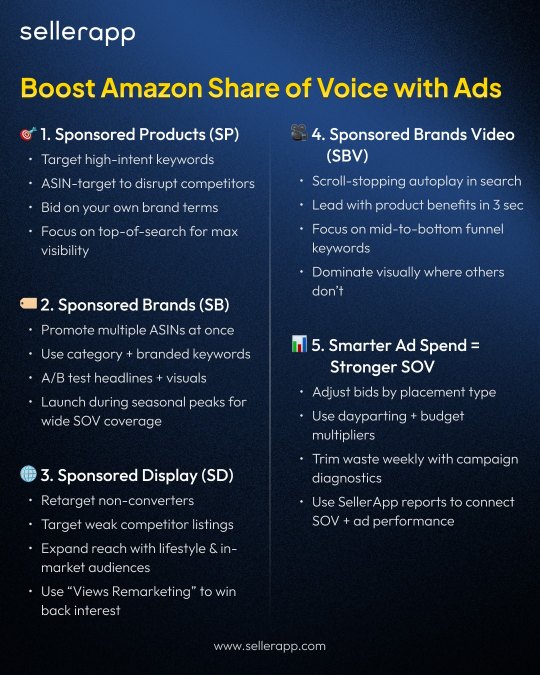
Once your listings are conversion-ready, Amazon Advertising becomes your most powerful tool for amplifying Share of Voice (SOV).
Here’s how each ad type plays a strategic role in boosting your Amazon share of voice:
1. Sponsored Products to Win the High-Intent Battleground
Sponsored Products (SP) ads are the core of Amazon PPC and the most direct route to capturing bottom-funnel traffic. These ads are keyword-triggered and ASIN-targeted, which means they show up when shoppers are actively searching with purchase intent.
Here’s how to use Sponsored Products to increase share of voice on Amazon:
- Target high-converting keywords where you are currently under-indexing in SOV.
- Use ASIN targeting to invade competitor listings space. If their listing is weak, the audience will click on your product, and you’ll land a sale.
- You can also add in branded terms to defend your presence against competitors bidding on your brand name!
- Keep your focus on top-of-search placements. These drive the majority of clicks and can dramatically expand your visible footprint.
2. Sponsored Brands to scale awareness across multiple ASINs
Sponsored Brands (SB) go beyond single-ASIN promotion. They elevate your brand presence across key keywords and allow you to showcase multiple products simultaneously.
To maximize their impact on Amazon’s share of voice:
- Run category-level campaigns targeting generic, high-volume keywords to build top-of-funnel share of voice for Amazon.
- Use branded campaigns to protect and dominate your own brand terms.
- You can also run an A/B test on custom headlines and brand imagery as strong creative assets boost CTR and improve ad relevancy scores.
Align your Sponsored Brands campaigns with key moments like product launches or seasonality. When used during peak windows, these campaigns can flood competitive SERPs and earn you more real estate, translating to a greater share of voice on Amazon.
3. Sponsored Display to expand visibility off-Amazon and Cross-Page
Sponsored Display (SD) is your gateway to retargeting, competitor conquesting, and off-Amazon awareness building. Unlike SP and SB, these ads follow shoppers across the web.
on product pages, customer review pages, and even third-party sites.
To expand the share of voice on Amazon with SD:
- Retarget shoppers who viewed your ASIN but didn’t convert. This improves conversion rates and reduces drop-off.
- Use product targeting to appear on competitor listings, especially those with weaker ratings or higher prices.
- Layer in audience-based targeting in your SD campaign (including lifestyle, interest, in-market) to scale top-of-funnel Share of voice (SOV) across relevant traffic segments.
Use “Views Remarketing” to nurture window shoppers into buyers. This not only increases your SOV but also improves the lifetime value of ad-attracted customers.
4. Sponsored Brands Video commands attention with scroll-stopping content
Sponsored Brands Video (SBV) ads are some of the most cost-efficient, high-impact formats in Amazon’s entire ad suite. They auto-play in search results, instantly grabbing shopper attention and driving both engagement and conversion.
Here’s how they amplify Amazon’s Share of Voice:
- Place them on high-priority keywords where your competitors are weak on visual content.
- Highlight differentiators such as quick benefits, features, and use cases within the first 3 seconds of the video.
SD campaigns work best when paired with mid-to-bottom funnel keywords to drive qualified clicks and boost ad efficiency. Video ads not only increase the share of voice (sov) in search, but they can also crowd out competitors visually.
5. Optimize Your Ad Spend to boost visibility without waste
Maximizing Share of Voice Amazon isn’t about spending more, it’s about spending smarter. You don’t need to be everywhere; you need to be precisely where it matters.
Here’s how advanced sellers optimize ad spend for Share of Voice on Amazon:
- Adjust bids by placement (top of search, rest of search, product pages) based on conversion intent and cost-per-click efficiency.
- Deploy dayparting and placement multipliers to concentrate spend during high-traffic hours or when competitors are offline.
- Run campaign diagnostics weekly to prune non-converting spend and reallocate to keywords that drive both visibility and sales velocity.
To uncover high-impact growth opportunities, we recommend that sellers triangulate data from three key sources:
- Ad performance metrics,
- Brand Analytics, and
- Share of Voice Amazon reports (that you can request from SellerApp’s Business Reports.)
Improve Product Reviews to Strengthen Share of Voice on Amazon
Great reviews influence buyers, and in addition to that, they influence Amazon’s algorithm.
If your product isn’t earning trust from customers, besides having lower ratings, it’s unlikely to earn premium shelf space on Amazon either.
Product reviews affect conversion rate, and conversion rate affects everything else. It impacts your organic ranking, positioning, and your ad efficiency almost like a vicious loop of declination.
In addition to that, the more Amazon sees your listing performing well, the more it rewards you with visibility. In other words, it fuels a higher Amazon Share of Voice.
Here’s how seasoned brands improve reviews to grow their share of voice Amazon.
1. Automate your review requests
No serious seller is manually clicking “Request a Review” on every order. Automation tools such as SellerApp review request tool help you send bulk requests for reviews, and it also shows you the correct timings for sending out the request. You can understand the timelines better and schedule review requests that are automatically sent.
Customers are more likely to leave a review when the product is fresh and performing as expected. These automation tools are designed to ensure consistency and efficiency without violating Amazon’s policies, and getting you more reviews that lead you to higher ratings and review counts.
These reviews are an excellent driving force to improve CTR and ad efficiency, pushing your products higher in the rankings, thus expanding your share of voice Amazon.
2. Tap into the Amazon Vine program
Struggling to gain traction on a new product? The Amazon Vine Program can help you jump-start reviews with credibility. Vine Voices are vetted, experienced Amazon reviewers who provide detailed, honest feedback to give your product a user’s perspective. Vine reviews often include images, videos, and rich descriptions, adding visual proof.
Enroll new, high-quality ASINs through Amazon Seller Central. You can provide up to 30 free units to generate authentic, photo/video-rich reviews.
We suggest you make the most use of Vine if you’re just starting out because early reviews act as conversion accelerators. This early traction improves performance in both organic search and Sponsored Ads and gives your sales momentum that directly results in a higher Amazon share of voice, especially in competitive categories.
Note: Not every product qualifies for Vine reviews. Use it for ASINs that are polished, priced right, and have inventory to support demand once traction kicks in.
3. Analyze reviews like you analyze ad performance
This is where seasoned sellers separate themselves from the pack. If you’re not learning from your reviews, you’re missing out on a goldmine of conversion and Share of voice Amazon optimization insights. Monitor recurring themes in both 5-star and 1–3-star reviews.
Tag issues around sizing, packaging, quality, missing info, or unrealistic expectations, and adjust your product detail page (images, bullets, A+ content) to clarify and address concerns before they turn into negative reviews from users.
When your messaging matches real-world expectations, return rates drop, and buyer satisfaction goes up. You can see that directly translates to better star ratings, higher conversion rates, and stronger ad performance. All of these are key signals that Amazon uses to decide which products deserve more visibility and a larger share of voice (Amazon).
You can use sentiment analysis tools or reports like SellerApp sentiment analysis business reports to cluster feedback by theme, then plug those insights into listing optimizations or, in the bigger picture, use them for product R&D.
How a Specialist Amazon PPC Agency Can Enhance Your Share of Voice (SOV)
Hiring an Amazon PPC agency such as SellerApp is more than just “outsourcing ads.” A top-tier Amazon PPC partner brings five hard-to-replicate advantages that directly impact your share of voice on Amazon, quarter over quarter. Let’s take a look at these advantages.
1. Algorithm-grade data architecture
Top-tier agencies build or license powerful data infrastructures that go far beyond what’s available in Seller Central. Instead of downloading ad reports manually, they stream real-time data from multiple sources. Amazon Ads API, Brand Analytics, Retail Analytics, DSP, and more into a centralized platform.
How does this grow SOV?
SOV is a live, shifting metric. Let’s say your share of voice on a high-intent keyword drops by 20% but your in-house team doesn’t catch it for days. That’s lost visibility, lost sales, and lost rank. A PPC agency detects these drops within hours, flags them against historical trends, and reallocates budget instantly. That agility lets you reclaim visibility before competitors entrench.
Agency impact: Agencies build alert systems for SOV thresholds, so they don’t wait for performance to tank; they course-correct before it does.
2. Competitive intelligence bidding engines
Reputable PPC agencies don’t just bid higher, they bid smarter. Using AI tools and alerts, they monitor competitive activity in real-time. They get into concepts like which ASINs are outbidding you, tiny shifts in CPC on core keywords, competitor pricing fluctuations, and other finer details.
How does this grow SOV?
Instead of playing catch-up with rising CPCs, agencies predict them. They can underbid when a competitor’s inventory is low, or aggressively defend brand terms the moment conquesting begins. This protects your Amazon Share of Voice while ensuring spend efficiency.
Agency impact: You win top-of-search placement not by overspending, but by outmaneuvering. There’s a difference that a seasoned PPC professional would know.
3. Creative testing lab
SOV isn’t just about where you show up. It’s about what you show up with. Agencies treat creatives like performance assets, not just regular branding pieces. They constantly test and iterate Sponsored Brand Videos (they determine length, narrative, CTA etc.), Display ad variations (images, copy, audience targeting etc.), and constantly run A/B testing on headlines and hooks
How does this grow SOV?
Better creatives translate to higher CTR. Higher ad relevance scores get your listing more impressions at a lower cost. That’s how you expand share of voice on Amazon without burning through your budget. Plus, visually optimized ads dominate real estate according to how A9 and A10 algorithms work.
Agency impact: A strong video ad on a high-volume keyword can single-handedly boost your SOV by 15–20% in competitive categories.
4. SOV-weighted budget throttling
Advanced agencies don’t distribute ad spend evenly. They build SOV-aware budget models that automatically shift spend based on current share of voice per keyword cluster, historical ROAS, and saturation thresholds.
So if you already own 70% SOV on a brand keyword, the system reduces spend and redirects it to underperforming but high-opportunity terms.
How does this grow SOV?
With these insights, you stop overfunding what’s already working and start investing in growth zones such as categories, keywords, or ASINs where your SOV is weak but your potential is strong.
Agency impact: This way, you’re not just defending the ground you’ve already won; you’re constantly pushing into new visibility frontiers that can unlock incremental sales, improved rank, and long-term competitive advantage.
5. Off-Amazon retargeting loops (DSP + Sponsored Display)
While most sellers focus only on search ads, agencies layer in retargeting to bring back high-intent traffic that didn’t convert the first time. They build full-funnel remarketing campaigns using Amazon DSP (offsite ads targeting cart abandoners and page viewers) and Sponsored Display’s “Views Remarketing” (on-Amazon retargeting)
How does this grow SOV?
Every recovered shopper adds to your conversion pool. As conversion rates increase, Amazon’s algorithm rewards your ASINs with higher placements and impressions, expanding your share of voice on Amazon even further.
Agency impact: Retargeted traffic converts at 2–4x the rate of cold clicks, making it an SOV booster with minimal CPC spend.
So why not boost your Share of Voice Amazon with SellerApp’s PPC Agency?
If you’re aiming to dominate Amazon search results SellerApp’s PPC agency can give you the tools, tech, and team to grow your Share of Voice (SOV) with precision.
Here’s how:
SOV-driven strategy
We benchmark your visibility across keywords, ASINs, and ad types to identify gaps in scalability.
Full-funnel targeting
Our AI automation model targets high-intent search terms and top-of-funnel keywords to expand and defend your brand reach.
Creative that converts
We design and test video, display, and Sponsored Brand assets that drive higher CTRs and bigger impression share.
Smart budget allocation
Spend flows dynamically toward areas with low Share of Voice (SOV) but high conversion potential, maximizing both ROAS and visibility.
Optimization that’s constant
With weekly insights tracking and expert support, your ad campaigns evolve as fast as the market does. So, you’re owning the space to make your brand visible to the consumers which goes beyond simply running ads.
How to use SellerApp’s Amazon Seller API solution to increase your Brand’s SOV?
Here’s how you can wield SellerApp’s ecommerce data API to increase your share of voice Amazon.
1. Identify where you’re missing visibility
Use SellerApp’s API to track how often your brand shows up for high-value keywords.
Spot underperforming areas and redirect ad budget where your share of voice Amazon is lagging. That’s your cue to show up where it counts.
2. Benchmark and adjust your pricing to win the Buy Box
The Amazon Price API helps you stay competitive by showing how your pricing stacks up against the top 10 rivals.
3. Take over when competitors run out of stock
Use the Inventory API to get notified when a competitor is out of stock, while also ensuring you stay on top of your own stock levels and lead times. That’s your green light to ramp up Sponsored Products or Display Ads and capture the attention (and sales) they’re missing out on, growing your share of voice Amazon footprint in the process.
4. Turn customer feedback into conversion power
The SellerApp Review API breaks down customer sentiment and recurring issues. Use this data to fine-tune your listings, visuals, and A+ content. Higher conversion means better ranking, better ads, and yes, higher Share of Voice Amazon.
5. Automate SOV tracking with a live dashboard
Integrate SellerApp ecommerce data API into a central SOV dashboard. Visualize trends by keyword, ASIN, and placement. Set alerts when your visibility drops and get clarity on where to scale, pause, or pivot. Think of it as mission control for your brand’s voice.
Final thoughts
In a marketplace as competitive and fast-moving as Amazon, Share of Voice (SOV) is a reflection of your brand’s influence. The higher your SOV, the greater your chances of driving traffic, conversions, and long-term growth.
Whether you’re optimizing listings, refining ad strategy, or partnering with experts, the goal remains the same, to secure meaningful visibility where it matters most. Because on Amazon, it’s about being seen, remembered, and chosen. So, invest in strategies and reporting solutions such as SellerApp Business Reports that don’t just boost impressions but help you build a presence.
Additional Readings:
Top 15 Ecommerce Marketing Tools You Should Use to Optimize Your Business Strategies
Automate Amazon Ads: A Complete Guide to Maximizing Sales
What is Seller SKU on Amazon and How to Create One?




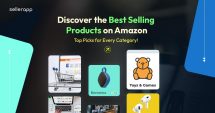




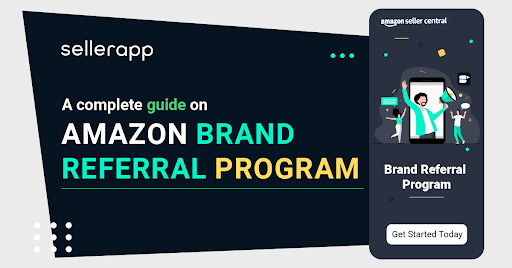

David tat
July 14, 2025A smart reminder that the more Share of Voice you own, the harder it is for competitors to catch up
Winfred Mup
July 15, 2025Love how this guide explains SOV as more than just impressions—it’s about market share.
Michael Craftman
August 14, 2025Share of Voice is such a powerful metric for measuring true visibility on Amazon.